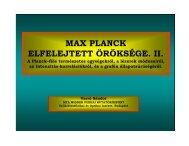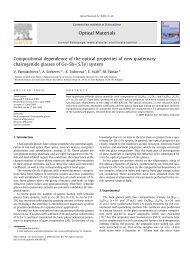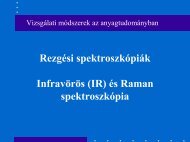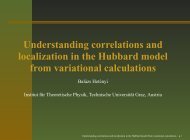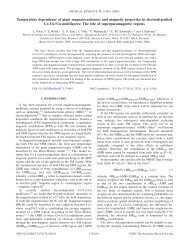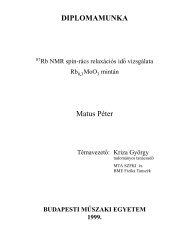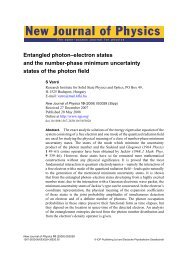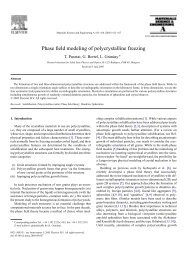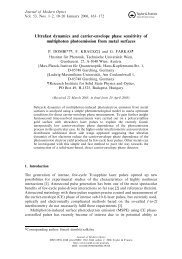ANNUAL REPORT - MTA SzFKI
ANNUAL REPORT - MTA SzFKI
ANNUAL REPORT - MTA SzFKI
You also want an ePaper? Increase the reach of your titles
YUMPU automatically turns print PDFs into web optimized ePapers that Google loves.
the α2 reconstruction increases on the surface, but the β2 phase remains within the whole<br />
temperature range, in agreement with previous experimental findings. Our results show<br />
that the combination of the experimental and theoretical results is a prerequisite for the<br />
accurate analysis of the SCLSs of the complex reconstructed surfaces.<br />
The surface core-level binding-energy shift of Pd at the Ag c Pd 1−c (111) surface is<br />
calculated as a function of bulk concentration of the alloy. The equilibrium volume and the<br />
surface concentration profile used in the calculations refer to the 0 K case. The SCLSs are<br />
evaluated within the Z + 1 approximation. The results are analysed using the mixing<br />
enthalpy of the alloy and the bulk and surface chemical potentials. A relation of the SCLS<br />
to the bulk concentration is considered. This relation is shown to be mediated by the<br />
surface concentration profile which induces the observed nonlinear behaviour. The results<br />
are interpreted using a simple model for the alloy electronic structure.<br />
We have performed first principles calculations with the density functional theory based<br />
VASP code to study the vibrational properties of various carbon nanostructures. In<br />
detail, the following topics were investigated:<br />
We calculated the Raman active longitudinal optical (LO) frequencies for carbon<br />
oligoynes and polyyne. We introduced a linear/exponential scaling scheme based on the<br />
exponential behavior of the carbon-carbon bond stretching force constant couplings in<br />
quasi-one-dimensional conjugated chains. This novel scaling scheme was found to yield<br />
frequencies that agree well with experimental results on long linear carbon chains<br />
encapsulated inside multiwalled or double walled carbon nanotubes. Vibrational modes of<br />
13 C isotope enriched single walled carbon nanotubes are inhomogeneously broadened due<br />
to the random distribution of isotopes. We studied this effect on the radial breathing mode<br />
theoretically and compared the result with experiments on inner tubes in double walled<br />
carbon nanotubes grown from 13 C-enriched fullerenes. We have found evidence of the<br />
absence of carbon diffusion along the tube axis during inner tube growth, supporting the<br />
theory of inner tube growth by Stone-Wales transformations from interconnected<br />
fullerenes. The energy dispersion of the D* (G') band shows a strong diameter dependence<br />
according to Raman measurements on double walled carbon nanotubes, with the Raman<br />
shift of the small diameter inner tubes showing an average softening. We have shown that<br />
the experimental observation can be reproduced by simple model calculations if the<br />
curvature effects are taken into account. The phonon softening with increasing curvature<br />
was proven by first principles calculations.<br />
We performed ab-initio calculations of the magnetic moments and magnetic anisotropy<br />
energies of small FeCo clusters of varying composition on top of a Cu(100) substrate.<br />
Three different cluster layouts have been considered, namely 2X2, 3X3 and cross-like<br />
pentamer clusters. The ratio of Co atoms with respect to the total number in a chosen<br />
cluster (”concentration”) was varied and all possible arrangements of the atomic species<br />
were taken into account. Calculations have been performed fully relativistic using the<br />
embedded-cluster technique in conjunction with the screened Korringa-Kohn-Rostoker<br />
method and the magnetocrystalline anisotropy energy (MAE) has been evaluated by means<br />
of the magnetic force theorem. A central result of the investigations is that the size of the<br />
magnetic moments of the individual Fe and Co atoms and their contributions to the<br />
anisotropy energy depend on the position they occupy in a particular cluster and on the<br />
type and the number of nearest-neighbors. The MAE for the 2X2 and 3X3 clusters varies<br />
with respect to the „concentration” of Co atoms in the same manner as the corresponding<br />
monolayer case, whereas the pentamer clusters show a slightly different behavior.<br />
14



